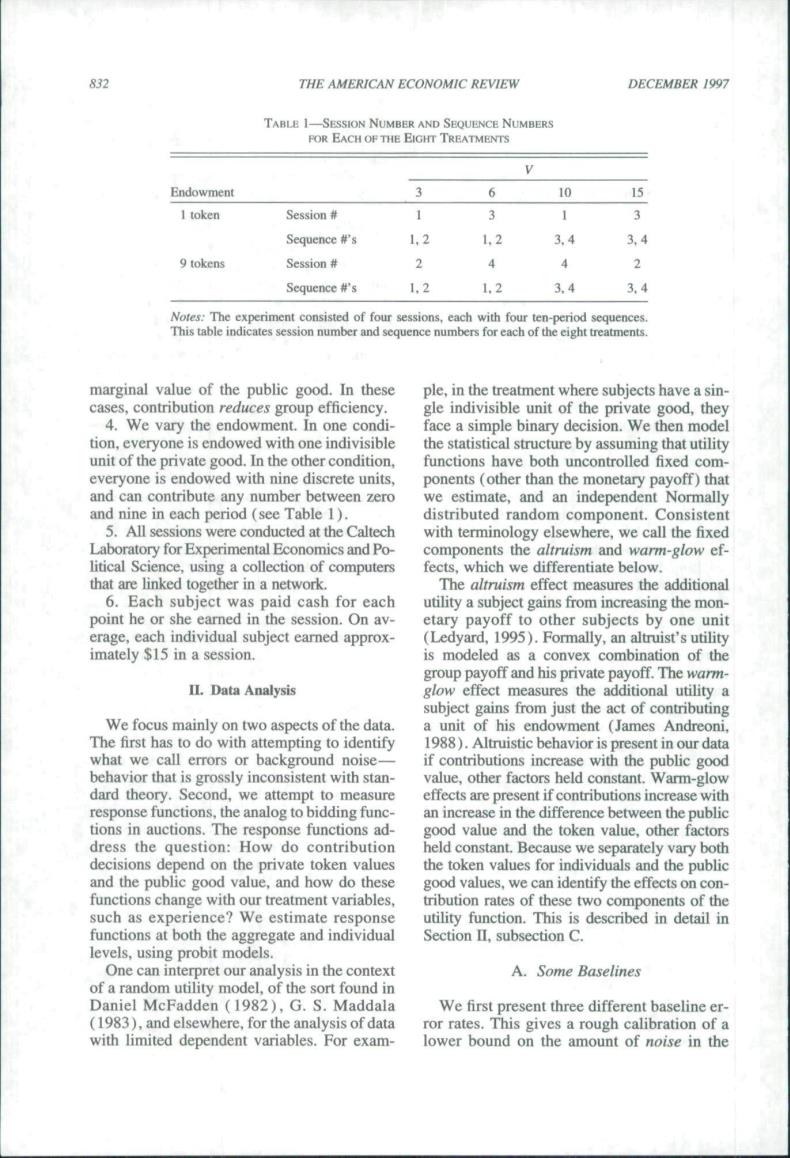正在加载图片...

832 THE AMERICAN ECONOMIC REVIEW DECEMBER 1997 Endowment 3 6 10 I token Session 1 Sequence s 1.2 1,2 34 34 Session 4 4 Sequence #s 1.2 1.2 34 3.4 ed of four each with four unit o the private good,they the statistical st y e by assu unit of the private good.In the other condition. functions have both uncontrolled fixed com everyone is endowed with nine discrete units ponents (other tha n the monetary payoff)that ute any numb een zero dis and an indepene 5.All sese s were conducted at the Caltech call the fixe Laboratory for Experimental Economics and Po- components the altruism and warm-glow ef. fects,which we differentiate below ism effec mea ures the additiona point he or she earned in the session.On av 网959.allyy on of the I.Data Analysis subject Andreon odo wi npting to identify 1)(o behavior is pre sent in onsistent with stan- other facto Wa n-gl dard theory.Second,we attempt to measure effects are present if contributions increase with the analog to bidding fun e in the din nce tween the pu decisions depend on the private token values the token values for individuals and the public and the public good value,and how do these s ch ange w doeieamtenthheecsoneo ch as funet ons at both the ag levels,using probit models. gate and Onecanintepretouranalysisinthecoi A.Some Baselines y1982) We firs (1983),and elsewhere,for the analysis of data or rates with limited dependent variables.For exam- lower bound on the amount of noise in the832 THE AMERICAN ECONOMIC REVIEW DECEMBER 1997 TABLE 1—SESSION NUMBER AND SEyuENCE NUMBERS FOR EACH OF THE EIGHT TREATMENTS Endowmeot 1 token 9 tokens Session # Sequence #'s Session # Sequence #'s 3 1 1.2 2 1,2 6 3 1,2 4 1.2 V 10 1 3.4 4 3.4 15 3 3.4 2 3.4 Notes: The experiment consisted of four sessions, each with four ten-.peHod sequences. This table indicates session number and sequence numbers for each of the eight treatments. marginal value of the public good. In these cases, contribution reduces group efficiency. 4. We vary the endowment. In one condition, everyone is endowed with one indivisible unit of the private good. In the other condition, everyone is endowed with nine discrete units, and can contribute any number between zero and nine in each period (see Table I). 5. All sessions were conducted at the Caltech Laboratory for Experimental Economics and Political Science, using a collection of computers that are linked together in a network. 6. Each subject was paid cash for each point he or she earned in the session. On average, each individual subject earned approximately $15 in a session. n. Data Analysis We focus mainly on two aspects ofthe data. The first has to do with attempting to identify what we call errors or background noise— behavior that is grossly inconsistent with standard theory. Second, we attempt to measure response functions, the analog to bidding functions in auctions. The response functions address the question: How do contribution decisions depend on the private token values and the public good value, and how do these functions change with our treatment variables, such as experience? We estimate response functions at both the aggregate and individual levels, using probit models. One can interpret our analysis in the context of a random utility model, of the sort found in Daniel McFadden ( 1982), G. S. Maddala (1983), and elsewhere, for the analysis of data with limited dependent variables. For example, in the treatment where subjects have a single indivisible unit of the private good, they face a simple binary decision. We then model the statistical structure by assuming that utility functions have both uncontrolled fixed components (other than the monetary payoff) that we estimate, and an independent Normally distributed random component. Consistent with terminology elsewhere, we call the fixed components the altruism and warm-glow effects, which we differentiate below. The altruism effect measures the additional utihty a subject gains from increasing the monetary payoff to other subjects by one unit (Ledyard, 1995). Formally, an altruist's utility is modeled as a convex combinatioti of the group payoff and his private payoff. The warmglow effect measures the additional utility a subject gains from just the act of contributing a unit of his endowment (James Andreoni, 1988). Altruistic behavior is present in our data if contributions increase with the public good value, other factors held constant. Warm-glow effects are present if contributions increase with an increase in the difference between the public good value and the token value, other factors held constant. Because we separately vary both the token values for individuals and the public good values, we can identify the effects on contribution rates of these two components of the utility function. This is described in detail in Section II, subsection C. A. Some Baselines We first present three different baseline error rates. TTiis gives a rough calibration of a lower hound on the amount of noise in the